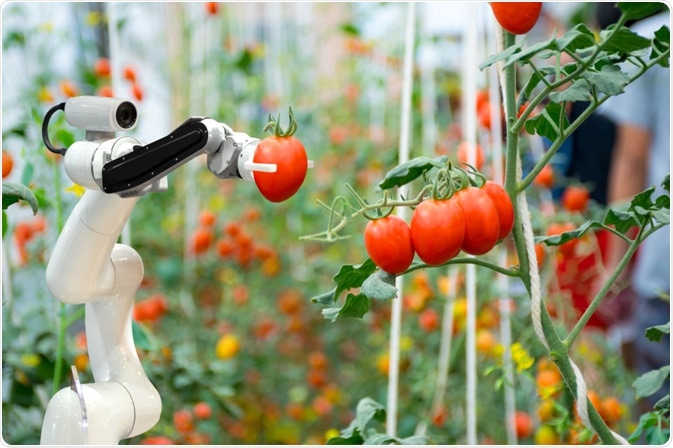Agricultural practices are continuously refined through the implementation of technological advancements. One such advancement is the use of automation in agriculture to enhance crop production, improve efficiency, and contribute towards better food security.

Lab Automation in Agriculture. Image Credit: kung_tom/Shutterstock.com
The development of automation
Automation is of growing interest across many disciplines and is currently applied across many aspects of modern life. First developed at the start of the 20th century, automation refers to a process or procedure conducted with minimal human assistance.
The first development of a self-propelled combine able to collect and thresh grains without human intervention dates to 1938. The subject of automated technology in agriculture was discussed succinctly in the 2009 book by Israeli researchers that compiled the major developments, progress, and outlook of automated machines in agriculture.
The authors present how technological progress proved fundamental to agricultural development. For instance, the implementation of electronic technology in the 1960s rapidly accelerated automated machinery with the advent of sensor technology, allowing machines to optimize energy use and adapt their activity to necessary conditions. Such progress was then confounded by the Global Positioning System (GPS) in the 1980s, further improving the accuracy of guidance capacities.
Agricultural practices in the modern era of automation
To date, automation has been applied throughout the process of food production. From field machinery and irrigation systems through to the automation of conditions in greenhouses and animal holding facilities. These tools have helped reduce operational costs while optimizing processes to maintain viable agricultural productivity.
In orchards, automated machines use differential object sizes and ultrasonic sensors to locate and harvest fruit from trees. The effectiveness of automated fruit harvesting was reviewed as early as 1998 in a study that discussed how variables such as canopy size and shape can be incorporated into sensors to better harvest available fruit. Integrating more characteristics into the identification system of machines was observed to improve the success of harvesting machines, with the review highlighting the benefits of integrating a greater role of robotics to enhance existing practices.
The implementation of automated processes has resulted in the reduction of labor costs and an increase in productivity, which directly improves the stability and outlook of stakeholders. Labour intensive operations are the most common beneficiaries as machines can replace human activity successfully at a reduced cost whilst also increasing the speed and success of processes such as seeding, monitoring, and harvesting.
Other applications of automation have helped mitigate some of the environmental repercussions of agricultural practices. This includes the automation of weeding operations, exemplified by an automated sensing and spraying system to eliminate mesquite canopies in 2002 by American researchers. This system was attached to tractors and had results rivaling the hand-spraying method of ground crews but with added accuracy to reduce non-target losses.
The application of automated processes has become increasingly common in modern agricultural systems, yet many caveats remain to be resolved. Knowledge gaps and limitations of automated processes were presented in a 2020 publication from the journal of Precision Agriculture. The review first discussed the economic benefits of automation in agriculture through reduced labor costs as well as increasing sustainability through increased efficiency.
However, the review highlighted the fact that despite experiencing the most pressing agricultural pressure, automation is rarely considered in less economically wealthy regions, which has resulted in a noticeable discrepancy in automation research focusing on already stable and viable systems.
The future of automated agriculture
Looking forward, the contribution of automated agricultural practices to food security is expected to increase. Automation will likely be applied to other elements of food production including the processing, transport, and quality control of produce.
The combination of automation with other technological advances such as machine learning will also bolster crop productivity as highlighted in a 2019 review in the Journal of Artificial Intelligence in Agriculture. The review discusses how machine learning can be used to further improve the use of pesticides, manage water and space use, as well as identify and target pests and pathogens.
The review advocates for the widespread implementation of machine learning as the natural successor to automated systems since automated machinery relies on basic software to determine suitable action patterns. The addition of machine learning capabilities will therefore improve the existing functional roles of automated machines as well as potentially develop new roles to further improve the efficiency of machines.
Enhancing the efficiency of automated machines by reducing the margin of error whilst reducing labor costs or the need for multiple machines will ultimately improve stakeholder security but also contribute towards more stable food security.
Ultimately, expanding automated machines and processes as well as refining existing techniques will provide many solutions to emerging issues. Such progress will improve the outlook of agricultural systems in the face of mounting environmental and societal pressure, whilst also contributing to the management of crop health.
References
- Edan Y., Han S., Kondo N. (2009) Automation in Agriculture. In: Nof S. (eds) Springer Handbook of Automation. Springer Handbooks. Springer, Berlin, Heidelberg. doi:10.1007/978-3-540-78831-7_63
- H. T. Wiedemann, D. N. Ueckert, & W. A. McGinty. (2002). Spray boom for sensing and selectively spraying small mesquite on highway rights of way. Applied Engineering in Agriculture, 18(6), 1. doi:10.13031/2013.11318
- Jha, K., Doshi, A., Patel, P., & Shah, M. (2019). A comprehensive review on automation in agriculture using artificial intelligence. Artificial Intelligence in Agriculture, 2, 1–12. doi:10.1016/j.aiia.2019.05.004
- Lowenberg-DeBoer, J., Huang, I. Y., Grigoriadis, V., & Blackmore, S. (2019). Economics of robots and automation in field crop production. Precision Agriculture, 21(2), 278–299. doi:10.1007/s11119-019-09667-5
- Robotics for Bioproduction Systems. (1998). Environment Control in Biology, 36(4), 261. doi:10.2525/ecb1963.36.261
Further Reading
Last Updated: Feb 19, 2021